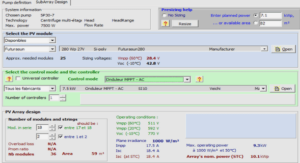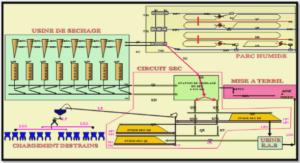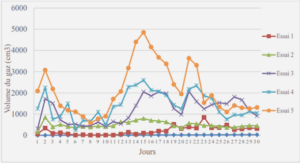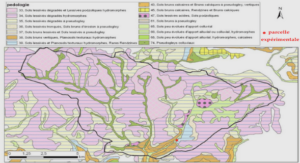Climate strongly shapes spectes range, demography and genetic diversity (Hewitt 2000; Thomas et al. 2004; Hoban et al. 2010). Both natural and anthropogenic causes, including the massive emission of greenhouse gas (GHG) and its accumulation in the atmosphere, drive climate change (IPCC 2007). Climate warming now occurs unequivocally, as global observation of widespread increase in temperature is recorded. This occurs, to even a greater extent, at higher northern latitudes (IPCC 2007). Consequently, one can envisage species range expansions, which will be marked most particularly for populations located at the limit of their range, which are more sensitive to rapid changes in elima te (Davis & Shaw 2001; !verson et al. 2004; Mimura & Aitken 2010). Marginal populations thus play an important role in the response to climate change when they hold evolutionary potential (Thomas et al. 2004; Hampe & Petit 2005). They may serve to originate further range expansion (Hunter Jnr & Hutchinson 1994).
Boreal trees species distribution usually becomes increasingly sporadic as one moves northward along a latitudinal gradient. Human activities superimpose upon climatic factors, contributing to population fragmentation at lands cape scale (Lesica & Allendorf 1995; Eckert et al. 2008). The populations at the edge of their range are subjected to marginality which may affect population genetic diversity due to decreased gene flow, increased fragmentation (Diniz-Filho et al. 2009; Tollefsrud et al. 2009; Hoban et al. 2010), and to relatively small population size (Lonn & Prentice 2002) .
Lack of reproduction may cause a decline in tree population. Sexual reproduction usually initiates re-colonisation following stand-replacing disturbances, e.g., forest tires. However,both climatic and biotic factors can limit sexual reproduction (Sirois 2000; Dorken & Eckert 2001; Prenne et al. 20 12). These factors result in the reduction of survival rates at various stages in the life cycle (e.g., pollination, seed dispersal, seed germination, seedling, establishment) (Woodward 1987). A progressive decline in success of sexual reproduction can lead to reduced capacity in these species to sustain themselves, as well asto colonise new sites (Tremblay et al. 2002; Messaoud et al. 2007).
GENE TIC CONSEQUENCES OF FRAGMENT A TION IN « ARBOR VITAE », EASTERN WHITE CEDAR (THUJA OCCIDENTALIS L.), TOW ARD THE NORTHERN LIMIT OF ITS DISTRIBUTION RANGE :
➤ Climate is among the most important ecological processes that strongly shape the range and genetic diversity of a species (Hewitt 2000; Thomas et al. 2004; Sexton et al. 2009; Ho ban et al. 2010; Provan & Maggs 2011). The well-documented central-marginal model (Diniz-Filho et al. 2009), which is also referred to as the abundant-centre model (Sagarin & Gaines 2002; Sagarin et al. 2006), predicts geographical variation in population genetic structure across a species’ range (Loveless & Harnrick 1984; Y akimowski & Eckert 2008). Populations at the edge of their distribution range are subject to ecological marginality, which may affect population genetic diversity due to harsher environmental conditions ( e.g., limited resources for growth and mating), isolation and fragmentation (Diniz-Filho et al. 2009; Tollefsrud et al. 2009; Hoban et al. 20 10). Fragmented populations may be prone to genetic loss and increased genetic differentia ti on through drift (Ellstrand & Elam 1993; Young et al. 1996; Aguilar et al. 2008). However, these responses are unlikely to be universal. Long-lived plant species, such as trees, may be buffered against genetic effects for decades or centuries (Templeton & Levin 1979; Cabin 1996; Piotti 2009). Tree species combine life-history traits that promote a high level of gene flow between populations, the maintenance of a high within-population gene diversity and low population differentiation (Hamrick et al. 1992). Thus, the genetic consequences of recent alterations to mating systems in rernnant fragments are sometimes not detectable for a long time (Garnache et al. 2003).
Methods
Study Area and Materials
Eastern white cedar, which is native to North America, is a wind-pollinated, monoecious, evergreen conifer species (Fowells 1965). An abundant seed crop occurs every 3-5 years, with cones opening in the autumn, but seeds may continue to fall throughout winter. Sexual maturity is generally reached at an early age, but effective seed dispersal is observed after age 20 years. Most seeds are disseminated by wind, with seed dispersal distances with estimates ranging from 45 to 60 rn (Fowells 1965). Eastern white cedar is a long-lived species, which can live up to 800 years in Quebec (Archambault & Bergeron 1992).
DNA Extraction, Microsatellite Loci Amplification and Genotyping
Foliage samples were ground, and genomic DNA was extracted using the GenElute Plant Genomic DNA Miniprep Kit (Sigma-Aldrich, St.-Louis, MO, USA). Amplification was performed by a gradient polymerase chain reaction (PCR) in a total volume of 10 uL using a 96-well GeneAmp PCR System 9700 (Applied Biosystems, Califomia, USA). Each reaction mixture contained 2.5 uL of DNA extract, 2.5 mM MgClz, 1 pmol each of forward and reverse primers, 0.2 uL of 10 mM dNTP Mix, 1 uL 10X NovaTag Hot Start Buffer and 0.25 U NovaTag Hot Start DNA Polymerase (Novagen PCR Kit, Madison, WI, USA). The best results were obtained by performing a touchdown PCR that decreased the annealing temperature by 0.2°C every other cycle. At the end of each cycle, we added a final noe extension step. Loci developed by O’Connell and Ritland (2000) for Thuja plicata and by Nakao et al. (2001) for Chamaecyparis obtusa were utilized for microsatellite genotyping. Four loci exhibited high polymorphism . Prior to electrophoresis, 0.5 uL of fluorescent dye labelled PCR products were mixed with 0.25 uL of internai standard (MapMarker-1000) and 10 uL of deionized formamide. The loading products were heat denatured at 95°C for 3 min, immediately placed on ice for 5 min, and separated using capillary electrophoresis on an ABI Prism 3130 Genetic Analyzer (Applied Biosystems). Microsatellites were sized and genotyped using GeneMapper 3.7 (Applied Biosystems).
Descriptive Statistics
Micro-Checker software (Van Oosterhout et al. 2004) was used to detect null alleles and large allele dropouts at each locus for each population. We used the program FreeNA to estimate the frequencies of putative null alleles [r] and genetic differentiation [Fst] with and without ignoring the null alleles at each locus (Chapuis & Estoup 2007). Allele frequency, allele number and genetic estimates within populations including the average number of alleles per locus [Na], average number of effective alleles per locus [Ne], observed heterozygosity [Ha], and expected heterozygosity [He] were calculated using GenAlex v. 6.2 (Peakall & Smouse 2006). We also calculated allelic richness [AR] using rarefaction and the inbreeding coefficient [Fis] at each locus. The calculations were performed using FSTAT v. 2.9.3 (Goudet 2001). We also calculated the aforementioned genetic estimates on pooled samples for each zone. Hardy-Weinberg equilibrium was tested in each population. We also ran a global test of Hardy-Weinberg equilibrium for pooled samples from three distribution zones and for all pooled samples as a group. Bonferroni correction (Rice 1989) was applied when testing the significance of heterozygosity deficit and heterozygosity excess. All of the HW equilibrium tests were performed in FSTAT v. 2.9.3 (Goudet 2001).
Population structure
Both Bayesian and NJT analyses detected a certain level of genetic structure among the 24 EWC populations. Interestingly, the four marginal populations (MZ1, I\.1Z2, MZ3, and I\.1Z4) from Chibougamau and one population (DZ6) from Abitibi were assigned to one cluster, even though more than 400 km separated DZ6 from the Chibougamau marginal populations. One explanation may be that these populations followed the same post glacial migration route. Apparently, the four populations from Témiscamingue (CZ1, CZ2, CZ3, and CZ4) belonged to the same cluster, indicating that gene flow (via seed or pollen dispersal) was high among them. Sorne sub-branches of the NJT were significant (bootstrapped values ~ 50), such as the sub-branch clustering of DZl and DZ5 or that of DZ2 and DZ3. These populations that clustered together are genetically doser and may have followed similar postglacial migration routes. Fourteen populations (marginal: MZ5, MZ6, MZ7, MZ8, and MZ9; discontinuous: DZl, DZ2, DZ3, DZ4, and DZ5; and continuous: CZ5, CZ6, CZ7, and CZ8) were assigned into a single (yellow) cluster.
GENERAL CONCLUSION
The impact of population fragmentation upon genetic structure of marginal EWC was the presence of a positive inbreeding coefficient. However, increased population isolation apparently did not correlate with a detectable effect on genetic diversity. Overall, the fragmented populations of EWC appear to be well-buffered against effects of inbreeding on genetic erosion. Therefore, increased inbreeding does not lead to a loss of genetic variation in northern EWC populations, which have the potential to respond and to adapt to environmental changes. The marginal populations would be able to play a major role as seed sources in further northward range expansion under favourable climate changes.
|
Table des matières
CHAPTER I GENERAL INTRODUCTION
1.1 Probletn Statement
1.2 Literature Review
1.2.1 The Species
1.2.2 Ecology
1.2.3 Regeneration
1.2.4 Genetics
1.3 Obj ective of This Study
1.4 Experimental Approach Used in the Research
GENETIC CONSEQUENCES OF FRAGMENTAION IN »ARBOR VITAE », EASTERN WHITE CEDAR (THUJA OCCIDENTALIS L.), TOWRD THE NORTHERN LIMIT OF ITS DISTRIBUTION RANGE
2.2 Abstract
2.3 Introduction
2.4 M ethods
2.4.1 Study Area and Materials
2.4.2 DNA Extraction, Microsatellite Loci Amplification and Genotyping
2.4.3 Descriptive Statistics
2.4.4 Latitudinal Effects on Genetic Estimates
2.4.5 Population Genetic Structure
2.4.6 Population Genetic Bottleneck
2.5 Results
2. 5.1 Descriptive Statistics
2.5.2 Latitudinal Effects on Genetic Estimates
2.5.3 Genetic Structure Patteming
2. 5. 4 Genetic Variation Partitioning
2.5.5 Population Genetic Bottleneck
2.6 Discussion
2.7 Conservation Implications
2.8 Acknowledgements
CHAPTER III SEXUAL OR ASEXUAL REGENERATION, WI-IICH IS MORE IMPORTANT FOR A LATE SUCCESSION AL SPECIES, EASTERN WHITE CEDAR (THUJA OCCIDENTALIS L.)?
3.1 Résumé
3.2 Abstract
3.3 Introduction
3.4 Material and Methods
3.4.1 The Species
3.4.2 Study Area
3.4.3 Sampling
3.4.4 DNA Extraction and Microsatellite Genotyping
3.4.5 Genetic Data Analysis
3.4.6 Fine-s cale Spatial Genetic Structure (SGS)
3.4. 7 Parentage Analysis
3.5 Results
3.5.1 Clonai Structure, Genetic and Genotypic Diversity
3.5.2 Fine-scale Spatial Genetic Structure (SGS)
3.5.3 Parentage Analysis, Family Structure and Gene Dispersal Distance
3.6 Discussion
3.6.1 Regeneration Dynamics along a Post-fire Succession
3.6.2 Gene Dispersal Distance Affects Family Structure
3.6.3 Clonai Growth Increases Fine-scale SGS and the Pattern of SGS along a Post-fire Succession
3. 7 Conclusions
3.8 Acknowledgements
CHAPTER IV IMPORTANCE OF LARGE OLD-GROWTH FOREST PATCHES IN MAlNTAINING THE GENETIC DIVERSITY OF »ARBOR VITAE », THE EASTERN WHITE CEDAR (THUJA OCCJDENTAUS L.), IN BOREAL FIRE-DOMINATED LANDS CAPES
4.1 Résumé
4.2 Abstract
4.3 Introduction
4.4 Materials and Methods
4.4.1 Study Area
4.4.2 The Species
4.4.3 Sampling
4.4.4 DNAExtraction and Genotyping
4.4.5 Data Analysis
4.5 Results
4.5.1 Genetic Diversity, Private A1lele and Test ofEquilibrium
4.5.2 Population Structure and Differentiation in the Landscape
4.5.3 Gene Flow in the Landscape
4.6 Discussion
4.6.1 The Differences of Genetic Diversity among the Three Lands cape Types
4.6.2 Gene Flow among Stands in the Landscape
4.6.3 Conservation Value ofFire Residuals
4.7 Conclusion
4.8 Acknowledgements
CHAPTER V GENERAL CONCLUSION
![]() Télécharger le rapport complet
Télécharger le rapport complet





